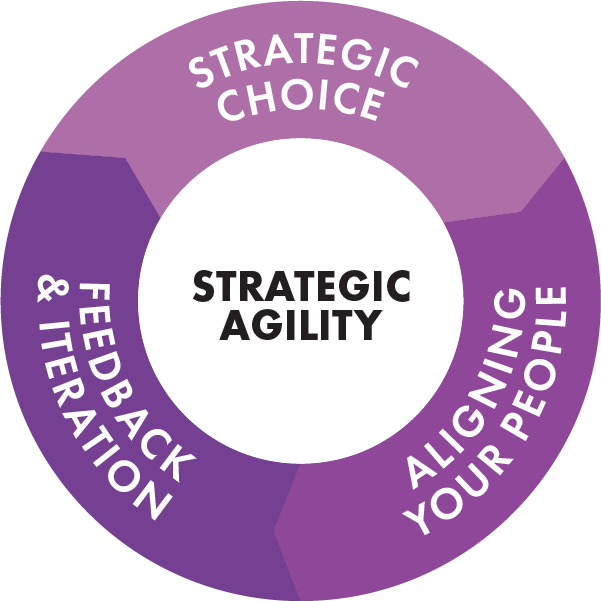In today’s dynamic world, an effective strategy must keep pace with change. Here’s how you can create all-important strategic agility and reach your goals faster.
That the pace of change is accelerating is now a well-established fact. Gone are the days when a 100-page strategy document can last you years.
So what does this mean for strategic planning? With constant change afoot, it’s easy to get swept up in responding to immediate needs and priorities. After all, adaptability is mission-critical in today’s economy.
Yet so is good strategy.
Strategy or Adaptability?
When we combine the need for clear strategy and adaptable organizations, we see that, in today’s day and age, strategic agility is a key competitive advantage.
Strategic agility is the core competency of making deliberate strategic bets, rapidly aligning your organization around those choices, and then using feedback loops to iterate as you move forward. It’s a self-reinforcing cycle that looks like this:

So keeping pace with change in today’s world is not about strategy or adaptability. It’s about having an adaptable approach to strategy.
With adaptability, strategy then becomes something that operates like a living organism rather than a static slide deck that gathers virtual dust after an initial “big bang.”
How to Get There, Faster
Even if the core elements of leading and managing strategy haven’t changed, the imperative for a faster cycle time has. This is where a visual and design thinking approach meets the demands for quality and speed.
Visual thinking is more than just pretty visuals. In fact, sometimes it’s a beautiful mess. Visual thinking uses visual means of facilitating, uncovering insights, and connecting the dots. When the end result also communicates information visually, it creates rapid clarity, better engagement, and faster alignment.
Design thinking is an approach that puts people at the center and uses a designer’s toolkit as well as an interactive approach to both create choices and make choices. It’s an exceptional way to tackle complex challenges, as it creates a structure that both accepts and helps manage and make sense from chaos.
Visual and design thinking approaches are highly inclusive, efficient, and effective. They make the strategy development process engaging and energizing even as they gather and synthesize a breadth and depth of input.
At XPLANE, we use a visual and design thinking approach to rapidly yet thoroughly identify where our clients want and need to go and chart the course from their present state to their desired future state.
We then create a clear, compelling visual story that can be rapidly disseminated throughout an organization. Building on that, we also use visual and design thinking to create strategy activation plans that allow our clients to mobilize people quickly around a shared vision and strategy.

To support continued agility, we use visual methods and design thinking to create metrics and feedback loops, and we facilitate strategic refreshes to ensure your people and actions continue to be aligned to an optimized strategy.
Five Ways to Take a Design Thinking Approach to Strategy
Here are five key components to taking a design thinking approach to strategy, all rooted in XPLANE’s design thinking approach:
- Make sure your strategy is customer centric. Strategies that focus on value to customers hold their relevance longer than strategies focused simply on growth, revenue, or output.
- Make your strategic planning process lightweight yet robust. If your planning process is arduous, you’ll be disincentivized to change when circumstances shift, or new insights arise.
- Make it visual. Visually communicated strategies are 60 to 70% more likely to be remembered. And a more memorable strategy is a more effective one!
- Include measurement. Benchmarking your progress against clear measures will enable you to know more clearly when you need to pivot.
- Revisit regularly. Stay engaged with your strategy and keep it incorporated in your regular communications and conversations. Don’t be afraid to go through a refresh and update your direction, your course to get there, or reset your vision.
Make Strategy an Iterative Journey
Investing in your strategy is a non-negotiable. A lack of strategic vision creates a vacuum whereby people in your organization can get sucked into responding to those ever-present immediate needs and the frenzy of what’s on the top of their inboxes.
Design thinking offers a lightweight yet robust way to achieve strategic clarity and agility. The key is to approach strategy as an iterative journey, refreshing your strategy and re-activating your people as you learn and grow—and as the world inevitably changes.
Additional Resources
Whether you’re in need of a clearer strategic vision, better alignment and engagement among your people, or a way to reset and re-energize your existing strategy, we’re here to help.
We can support you in building the rhythms necessary for strategic agility: co-creating your strategy, refreshing it as needed, and continuing to communicate, connect, and activate your people around it.
Check out how we’ve helped our clients and reach out if you have any questions.
You can also dive a bit deeper into strategy and agility with these resources:
